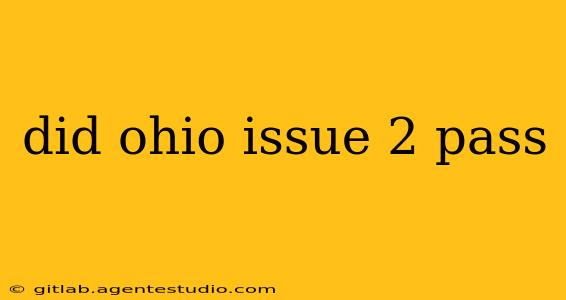Ohio Issue 2, the proposed amendment to the state constitution regarding the process of amending the state constitution itself, failed decisively in the August 8, 2023, special election. This outcome has sent shockwaves through Ohio politics and has significant implications for future legislative efforts. Let's delve into the details surrounding this pivotal election.
Understanding Ohio Issue 2: What Was at Stake?
Issue 2 aimed to dramatically increase the threshold for passing future constitutional amendments. Instead of needing a simple majority (50% + 1 vote), it would have required a 60% supermajority. Proponents argued this would protect the state constitution from being easily altered by special interest groups and ensure more thoughtful consideration of amendments. Opponents, however, countered that it was a blatant attempt to suppress the voices of voters and make it nearly impossible to pass crucial amendments in the future. The core of the debate centered around who should have the ultimate authority to decide on constitutional changes: the electorate or a higher threshold of support within the legislature.
Key Arguments For and Against Issue 2
Arguments in favor primarily focused on preventing what supporters perceived as "radical" changes to the state constitution driven by well-funded special interest groups. They emphasized the need for greater stability and deliberation in the amendment process.
Arguments against portrayed Issue 2 as an undemocratic power grab, designed to make it harder for citizens to directly influence their government through constitutional amendments. They highlighted the potential for this to stifle important initiatives supported by a majority of Ohioans.
The Results: A Resounding "No"
The results were clear and decisive: Issue 2 failed. The "no" votes significantly outnumbered the "yes" votes, demonstrating widespread opposition to the proposed changes. This outcome represents a significant victory for those who advocated against raising the threshold for constitutional amendments.
Fallout and Implications: What Happens Now?
The failure of Issue 2 has several important implications:
-
Future Amendment Efforts: The current amendment process remains in place, meaning future constitutional amendments will still need a simple majority to pass. This opens the door for various groups to pursue their legislative goals through the ballot initiative process.
-
Political Landscape: The election results have significantly shifted the political landscape in Ohio. The decisive rejection of Issue 2 underscores the strength of public sentiment against perceived attempts to restrict voter rights and influence.
-
Trust in Government: The outcome could be interpreted as a reflection of public trust (or lack thereof) in the state government and its efforts to influence the amendment process.
-
Upcoming Elections: This result will likely influence the upcoming November elections, where several other crucial issues will be on the ballot.
Conclusion: A Significant Victory for Voter Rights
The defeat of Ohio Issue 2 is a significant event in Ohio's political history. It demonstrates the power of citizen engagement and underscores the importance of protecting the right of the electorate to directly influence the state's constitution through the amendment process. The outcome highlights the need for open, transparent, and accessible avenues for citizen participation in shaping their state's future. The debate surrounding Issue 2 will undoubtedly continue to shape Ohio politics for years to come.

